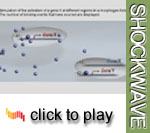 bicoid
and nanos regulate the translation of two other maternal mRNAs present
in the embryo: hunchback and caudal. hunchback and
caudal mRNA are uniformly distributed throughout the embryo. nanos,
the posterior determinant, represses hunchback translation, leading
to a Hunchback protein gradient complementary to that of Nanos. Similarly,
translational repression of caudal through bicoid leads to
a posterior Caudal gradient.
bicoid
and nanos regulate the translation of two other maternal mRNAs present
in the embryo: hunchback and caudal. hunchback and
caudal mRNA are uniformly distributed throughout the embryo. nanos,
the posterior determinant, represses hunchback translation, leading
to a Hunchback protein gradient complementary to that of Nanos. Similarly,
translational repression of caudal through bicoid leads to
a posterior Caudal gradient. Although Bicoid acts as a translational repressor, its main function is the transcriptional regulation of downstream zygotic target genes. bicoid cooperates with maternal hunchback in the regulation of zygotic genes expressed in the anterior region of the embryo: orthodenticle, buttonhead, empty spiracles, zygotic hunchback and the anterior stripe of giant expression. Together with caudal, it regulates genes in the posterior region, like knirps and the posterior stripe of giant expression. In contrast to the dual function of bicoid as a regulator at the DNA and RNA level, the sole role of nanos is to repress maternal hunchback translation. How the target genes of Bicoid, Hunchback and Caudal pattern the embryo, eventually leading to its subdivision in 14 segments, is extensively discussed under the topic segmentation.
 The
fact that bicoid acts very early in development in a large syncytial
cell is the prerequisite for the rare circumstance that it is a transcription
factor AND a morphogen. As soon as cells are present, morphogens would have
to move between them.
The
fact that bicoid acts very early in development in a large syncytial
cell is the prerequisite for the rare circumstance that it is a transcription
factor AND a morphogen. As soon as cells are present, morphogens would have
to move between them. The different responsiveness of target genes to bicoid concentration translates the gradient into a spatial pattern. A gene X, responding to a certain concentration of bicoid will be active only in a defined region of the embryo. A gene Y may respond to a different concentration of bicoid. Therefore, the clue for the spatial organization along the anterior-posterior axis lies in the cis-regulatory regions of the target genes. In addition to Bicoid, factors like Hunchback and Caudal, cooperate in conveying positional information.
Media list
Genes discussed
|
Gene
|
Gene product
- Domains
|
Function
|
Links
|
|
bicoid
(bcd)
|
transcription factor - homeodomain
|
maternally provided morphogen involved in anterior
patterning of the Drosophila embryo
|
|
|
buttonhead
(btd)
|
transcription
factor - zinc finger
|
transcriptonal
activator that regulates the segmentation of the head
|
|
|
caudal
(cad)
|
transcription
factor - homeodomain
|
plays a role in establishing the posterior domains
of the embryo
|
|
|
empty
spiracles (ems)
|
transcription
factor - homeodomain
|
required for head + brain development
|
|
|
hunchback
(hb)
|
transcription factor - zinc finger |
gap gene, later required for proper temporal generation
of NB sublineages
|
|
|
nanos
(nos)
|
translational
repressor - zinc finger
|
targets
Hunchback- and Bicoid-mRNAs to achieve posterior identity
|
|
|
orthodenticle
(otd)
|
transcription
factor - homeodomain - paired-like
|
acts in a combinatorial fashion with the cephalic gap
genes empty spiracles and buttonhead to
assign segmental identities in the head and brain
|